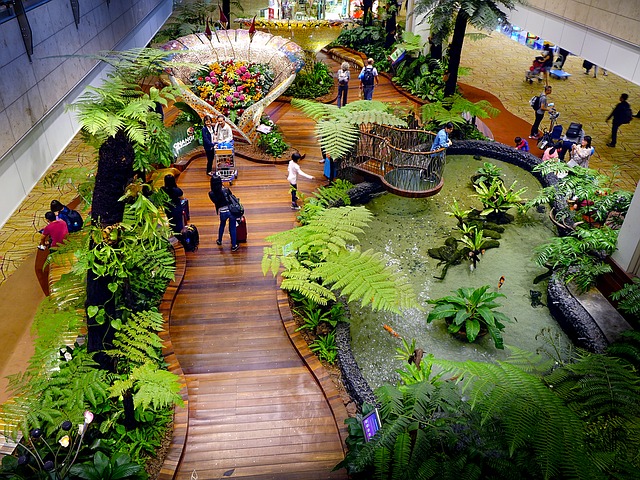Highs and Lows of Southeast Asia’s International Airports

Those of us from the bottom corner of the world (that is, Australia or New Zealand) who are used to travelling to Asia, or to Europe via Asia, know very well that the most comfortable way of doing so is via Singapore. The little Asian powerhouse of a city-state has long prided itself on its immaculately clean streets—where you can be fined for chewing gum or not flushing a toilet—as well as on its luxurious national carrier, Singapore Airlines, and Changi Airport.
A long layover in Changi is certainly not a hardship: there are designated sleeping areas (with reclining chairs and dimmed lights) and a butterfly garden, as well as the usual amenities that one should expect from an international airport, such as a variety of food, duty-free shops and showers (only better, because it’s Singapore).
Singapore exemplifies what the New York Times calls the concept of airport-as-brand, and has been doing so successfully for many years, at least since the early-mid 1990s, when I first started transiting through there.
Many Asian countries consider their main international airports and airlines a source of national pride, a way to demonstrate to the world that they should be taken seriously.
Many other Asian airports, especially in big cities such as Kuala Lumpur and Bangkok, have similarly flashy and comfortable airports, although none quite meet the standard of Singapore’s Changi. It can be quite a shock, then, for us Antipodeans to realise that long-distance air travel in much of the world—North America especially, but Europe too—doesn’t automatically come with such comfort. A long layover in Heathrow, Charles de Gaulle, JFK or LAX? Yuck, no thanks.
The reasons for these disparities are of course multiple, but part of the story is that many Asian countries consider their main international airports and airlines a source of national pride, a way to demonstrate to the world that they should be taken seriously.
New York City knows it’s important and so does everyone else. It doesn’t have to convince anyone. A tiny country such as Singapore had to reinvent itself after its freedom from Britain in the 1960s, and dragged itself to the economic importance that it has today. An impressive airport and national airline are symbolic of its success.
New York City knows it’s important and so does everyone else.
Singapore is a stand-out case. Not all of Southeast Asia’s airports or airlines come anywhere close to it in terms of facilities or service. Yet, from travelling around the area it is evident that Changi and Singapore Airlines is considered a benchmark of sorts, something to aim for.
Indonesia’s national airline, Garuda Indonesia, was once notorious for its poor safety record. And while its on-time performance is still poor, it now proudly boasts the official title of one of the ‘world’s most improved airlines’—although that won’t necessarily console you if you are stuck in (the decidedly un-fancy airports of) Bali or Jogyakarta for hours because you missed your connection due to your Garuda flight’s late arrival…
Even my favourite travel horror story is now more of a historical anecdote than a cautionary tale, as it’s unlikely to happen these days. In December 2013, on a long overnight layover between Kathmandu and Sydney in KL’s Low-Cost Carrier Terminal—not KL’s main airport, but the one that budget airline Air Asia flies from—I found a bench on which to nap for a few hours.
After an hour or so I woke up because my right side, the side lying on the ripped-up upholstery, was itching intensely.
Tired enough to block out the incessant, unintelligible announcement and flickering neon lights, I managed to doze. After an hour or so I woke up because my right side, the side lying on the ripped-up upholstery, was itching intensely. I rushed to the bathroom and found that my thighs (and ‘upper thighs’) were covered in red bites.
Fleas were my guess. I was upset about the bites, but I was even more upset that I still had about eight hours left in the godforsaken hellhole of an airport and nowhere even semi-comfortable to take a nap.
Six months later I was passing through KL’s LCCT again (between Kathmandu and Sydney, again). I was dreading it after my previous experience, but found that in the intervening months, the airport had been replaced. The LCCT is now basically a shopping mall with Air Asia’s check-in counters on one floor. Yes, a lot of airports the world over are intensely commercialised, encouraging you to spend, spend, spend more than you already have on your trip, as if the sole purpose of travelling is to buy duty-fee perfume, alcohol and cigarettes.
Luxury and Fleas: Highs and Lows of Southeast Asia’s International Airports
But KL’s new LCCT takes this to new heights, with an entirely mall-like layout and regular high-street shops, not just the ‘luxury’ brands that we are all used to seeing in airports. I even had to ask an employee the way to the check-in counters. I got the impression that nobody would have minded if I’d missed my flight from getting distracted by the shopping. That was, perhaps, the intention.
Photo by Pixabay.









One thought on “Highs and Lows of Southeast Asia’s International Airports”